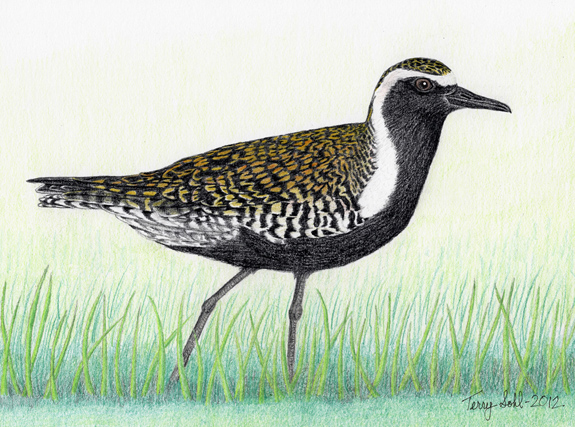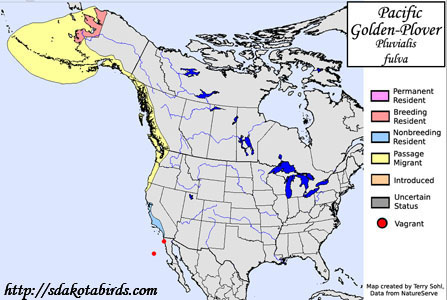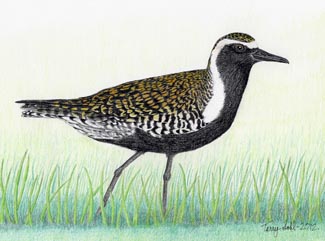Pacific Golden-Plover
Pluvialis fulva
| Length: 10 inches | Wingspan: 24 inches | Seasonality: Non-resident in South Dakota |
| ID Keys: In breeding plumage, golden and black spotting on upperparts, black below, narrow white neck and head band | ||
 Until
1993, the Pacific Golden-Plover and the
American Golden-Plover were
considered one species. However, despite the very similar appearance between
the two species, breeding habitat, breeding calls, and migration patterns
are different, and it is thought the two species rarely, if ever,
interbreed, despite being found in the same general region of western Alaska
in the summer. They also breed in northeastern Asia.
Until
1993, the Pacific Golden-Plover and the
American Golden-Plover were
considered one species. However, despite the very similar appearance between
the two species, breeding habitat, breeding calls, and migration patterns
are different, and it is thought the two species rarely, if ever,
interbreed, despite being found in the same general region of western Alaska
in the summer. They also breed in northeastern Asia.
Habitat: Found on Alaskan tundra during the summer breeding season. During migration and in winter, they can be found in a variety of open habitats.
Diet: During the summer breeding season, primarily feeds on insects, as well as berries and seeds. In migration and in winter, feeds heavily on small crustaceans and molluscs, as well as insects.
Behavior: Feeds by running on the ground, visually identifying food items and plucking them up with the bill when found. They are gregarious, and typically forage in small to moderately sized flocks of up to 100 birds or more.
Nesting: The nest of the Pacific Golden-Plover is a small depression on the ground, lined with lichens, moss, dry grass, or other plant material. Both parents incubate the eggs. Both parents also typically help tend to the young, but occasionally the female will leave and the male alone will raise the young. Just after hatching, the fledglings must find their own food (typically insects), while the parents defend them from danger.
Song: Song of the Pacific Golden-Plover, given during flight displays, is a plantive whistling, tee chee-eee. Will also give a simple two-toned flight call, with a stronger second syllable.
Migration: Highly migratory. Pacific Golden-Plovers breed in western Alaska. In the fall, most birds move to islands in the Pacific, with significant numbers migrating all the way to New Zealand or Australia. Small numbers of Pacific Golden-Plovers may also winter on the U.S. West Coast.
Interactive eBird Map: Click here to access an interactive eBird map of Pacific Golden Plover sightings
Similar Species: American Golden-Plover, Black-bellied Plover
Conservation Status: There are currently no perceived major threats to Pacific Golden-Plover populations, and the IUCN currently lists Pacific Golden-Plovers as a species of "Least Concern".
Further Information: 1) Cornell's All About Birds - Pacific Golden-Plover
2) Audubon - Pacific Golden-Plover
3) BirdWeb.org - Pacific Golden-Plover
Image Information: Pencil drawing by Terry Sohl - February 2012
| Click below for a higher-resolution map |
 |
| South Dakota Status: Non-resident in South Dakota |
Additional Pacific Golden-Plover Images

